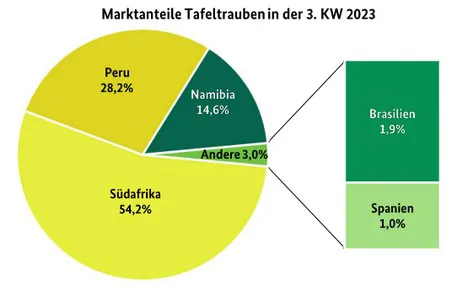An extensive and wide range of grapes was available. Increasing shipments from South Africa and slightly weakening imports from Peru played a large role. New additions were South African Thompson Seedless, which cost €16 to €20 per 4.5 kg box in Frankfurt. Imports from Namibia, Brazil and Spain were more of a supplementary nature. According to the BLE, demand could generally be met without any problems. In some cases, it was limited, but in some cases, sales possibilities improved. The prices, which did not show any clear trend, developed accordingly.

There were price increases as well as reductions, and a widening of the price range was also quite noticeable. In some places, availability was somewhat too weak overall, with the result that prices tended to rise. There were also returns from food retailers, but this had little effect on the turnover of regular merchandise.
Apples
As before, domestic offerings formed the basis of supply. In terms of importance, Italian batches followed. There were comparatively few deliveries from France, the Netherlands, Belgium and Poland. Overall, business was rather slow. Demand was satisfied without difficulty.
Pears
Italian Abate Fetel, Santa Maria and Williams Christ predominated. Turkish Santa Maria were flanked by a few Deveci of the same origin. Primarily Conference and Association Dechants pears arrived from the Netherlands. Dutch Alexander Lucas stocks were too large here and there, which led to discounts.
Oranges
Spanish deliveries still dominated: Various Navel varieties were predominant, Navelina in particular. Meanwhile, the first Navel appeared in Munich. Salustiana gained in importance. The presence of Turkish and Moroccan imports increased; in terms of their organoleptic characteristics, they were quite able to compete with the Spanish products.
Small citrus fruits
Mandarins now appeared to have a firm grip on the market: in addition to the expanding Spanish Clemenvilla, Clemenova, Nadorcott and Tango, there were many other varieties. Israeli orris followed in terms of importance, but were not consistently convincing in terms of quality, which is why their price range opened up in both directions.
Lemons
Spanish Primofiori dominated the scene, Turkish Lama and Primofiori complemented them. Italian fruits played only a small supporting role. The demand was quite nice, but could be satisfied without any problems.
Bananas
Marketing was uneven and prices developed accordingly: In Munich, the entire range was slightly cheaper due to demand. In Cologne, meanwhile, only the first brand became cheaper, while the second brands and third brands from Colombia became slightly more expensive.
Cauliflower
Italian offers outweighed French ones. Spanish goods, like domestic ones, were available only sporadically. Availability was limited, and French batches in particular were in short supply in some cases. Prices then shifted upward, in some cases quite strongly.
Lettuce
Iceberg lettuce exclusively came from Spain. Their presence was noticeably limited, with weather-related crop failures and promotions in the food retail sector causing a shortage of supply in some places. As a result, prices climbed, in some cases significantly.
Cucumbers
The availability of predominant Spanish cucumbers diminished. Demand was nevertheless satisfied without major difficulties. Prices were mixed, but for the most part they rose rather than fell. Greek shipments rounded out the range on a small scale.
Tomatoes
The goods flow from Belgium and the Netherlands dropped off, as had the one from Spain. Nevertheless, a wide assortment was available, in which many different countries participated. The quality of the produce was mostly good. Here and there, the coloration of Moroccan imports was less than stellar.
Sweet peppers
Although the supply was slightly limited, it was sufficient to satisfy the demand. Spanish deliveries apparently dominated over Turkish imports. The assortment was rounded out by shipments from Morocco. In Berlin, red pointed peppers from Jordan appeared repeatedly. As in the previous week, prices often went up.
Source: BLE
